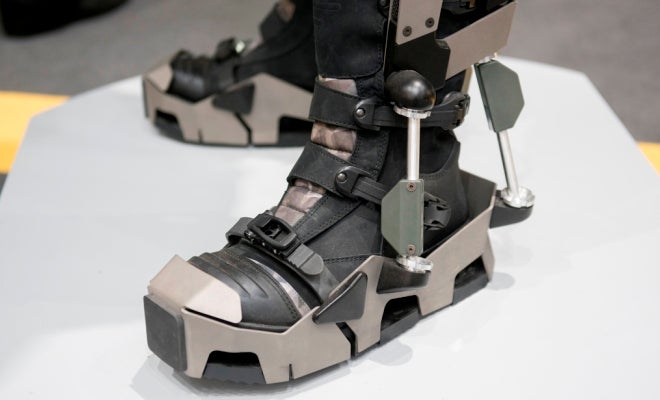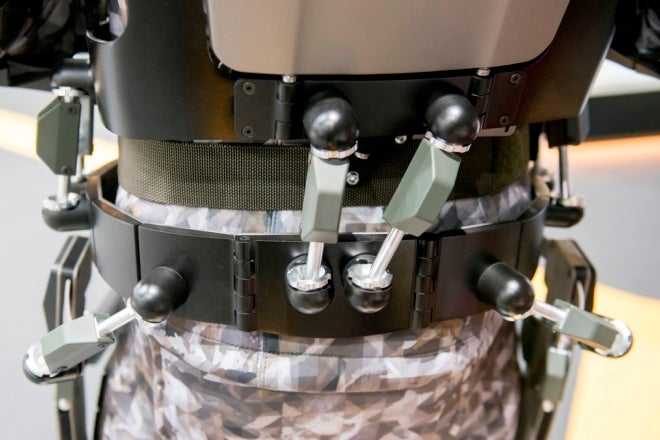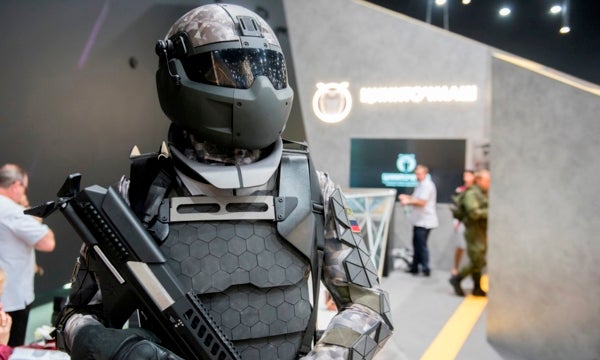In an interview given to TASS news agency, Dmitriy Semizorov, the CEO of TsNII TochMash has revealed some of the features of the Ratnik-3 future soldier equipment that is being developed for the Russian military. Let’s see what new has become known.
Designations
First of all, Semizorov clarified the designations of different generation equipment. Russia’s first unified equipment was called Permyachka. The second generation equipment which is adopted and is being used right now is called Ratnik. And the third generation that they are currently developing and plan to adopt by 2020, is called Ratnik-3. The “3” in Ratnik-3 doesn’t mean that it is the third Ratnik but means that it is a third generation equipment. There is no such thing as Ratnik-2. The second generation “Ratnik” has been mistakenly called Ratnik-2.
So there was Gen1 “Permyachka”, now they use the Gen2 “Ratnik” and there will be the Gen3 “Ratnik-3” in future.
Mine Detecting and Mine-Proof Boots
Semizorov talked about the advanced footwear that is being developed for the Ratnik-3. The new boots will have built-in sensors which will detect the mines in the way of the soldier and inform about it immediately. They are also working to make the new boots mine proof. The boots must be able to protect from a typical anti-personnel mine explosion. Another feature that they are planning to add to the boots or other parts of the equipment will be a system of “minefield suppression”. I assume this means the ability to jam the remote-controlled IED signals.

According to the company CEO, such footwear already exists but it is too big and bulky to be issued to the troops. They are working to make it reasonably compact and field usable.
IR Camouflage
Nowadays, it is important not only to have a visual camouflage but also an IR one. The Ratnik-3 uniform fabric will be capable of blocking the heat coming from the soldier’s body thus making him invisible for thermal imaging devices. According to Semizorov, a soldier wearing a uniform made of this kind of fabric is virtually undetectable by the helicopters even at night and in open areas.
Hearing Protection
Ratnik-3 will have a built-in hearing protection partially similar to the existing ones. It will be able to amplify the low sounds to a certain level and block the loud sounds (gunfire, explosions etc.) to a hearing safe level. They are working to incorporate a system of microphones that will also allow detecting the direction that both amplified and reduced sounds come from.
Eye Protection
The Ratnik-3 glasses won’t only provide eye protection but accomplish a number of other tasks. The glasses and visor will be able to display to the soldier any information including maps, view from the scope for shooting from cover, the view from the cameras of unmanned vehicles, the trajectories, and points of impacts of various projectiles etc. Right now they are projecting the information onto the inner surface of the glasses. In future, they hope to develop a visor which would have built-in liquid crystal solutions.
Automatic Tourniquets
The Ratnik-3 uniform will have a number of built-in tourniquets. As of today, they have the prototypes of these TQs, but they are only manually operated ones. In future, they plan to make those tourniquets automatically actuated. The system will be able to detect the wound and necessity to apply a TQ. The small electric motors attached to the TQs will start tightening them until the blood loss is stopped.
Besides having the manual and automatic modes, these tourniquets will be also remotely controlled. In case if the automatic system failed and neither the wounded soldier can manually apply the TQ nor other soldiers can reach him to help, the system will alert the teammates and command about the condition of the wounded soldier. This will let the teammates remotely activate the proper tourniquet on the wounded soldier’s uniform.
There will possibly be a built-in med kit too which will be able to automatically inject the required medicine. The sensors that will be gathering the information concerning the soldier’s health status will be placed all over the soldier’s body: on legs, arms, torso, head etc. The sensors will constantly monitor the soldier’s heartbeat rate, body temperature, pulse, respiratory rate, electrodermal activity etc. This system must be custom pre-adjusted for each soldier because of normal vital data differences depending on soldiers’ age, sex, weight etc.
Exoskeleton
Exoskeletons are being developed to help soldiers carry their everyday loadout as well as make it possible to carry other heavy objects that would otherwise be very difficult or impossible to move manually.
The TASS reporter asked Dmitriy Semizorov if the adoption of an exoskeleton will lead to the adoption of a larger caliber and more powerful ammunition capable of penetrating the modern armor. Semizorov admitted that the modern personal armor is ahead of most of small arms ammunition. He said that although it looks like they have currently squeezed everything possible (in terms of penetration) from the 5.45x39mm cartridge, they still need to experiment with newer materials. According to Semizorov, increasing the caliber is one of the solutions but not the only one. He points out the drawbacks of adopting a larger caliber, namely the need for heavier and larger weapons and logistics issues. Although the exoskeleton will allow using larger weapons, its main purpose is to increase the soldier’s endurance and agility.

The main power mechanism that they consider now for the exoskeleton are electric motors. They also work on creating artificial muscle tissue which will be capable of contracting driven by electrical impulses. Pretty much like the human muscles work. The developments of such technologies are in very early stage and if they become something usable and financially reasonable in the foreseeable future, then they may consider using these technologies in exoskeleton construction.
The current electrical motor driven exoskeleton faces a number of challenges too. It must be capable of instantly reacting to the soldiers’ motions in all directions to amplify these motions and not constrict them. Right now they have a prototype of the exoskeleton made of titanium. They are working on refining its electrical powering mechanism. The most significant challenge now is to develop compact enough power source. According to the technical requirements of the Ratnik-3 exoskeleton, the fully charged battery pack must be powerful enough to allow continuous use of the exoskeleton for 24 hours.
Armor
Perhaps the most satisfying component of Ratnik and Ratnik-3 is the armor. Both the helmet and armor vest proved to be highly effective. If the mission requires so, additional armor plates can be added providing protection for the shoulders, torso sides, arms, and groin. Additionally, an armored cloak can be used which will provide shrapnel protection for the entire body. As Semizorov says, they are not going to “make a tank for an individual soldier” and the mobility is also important.
Most of these armor solutions are employed in the current Ratnik equipment. For the Ratnik-3, they have a task to make the armor 25-30% lighter keeping its protection level. Right now the Ratnik armor weighs 24 kilograms (about 53 lbs). Their task is to decrease the weight to 20 kilograms (44 lbs).
At the end of the interview, Semizorov said that they are extensively using the feedback from the units that use the Ratnik. They have a list of about 200 improvements that the soldiers would like to see in their equipment. The transition from Ratnik to Ratnik-3 will be a gradual process. They’ll be adding the Ratnik-3 modules to the existing equipment which will eventually lead to the complete transition to the third generation.
That’s the latest news concerning Russian Ratnik-3 equipment developments. As always, as soon as new information appears it will be delivered to our readers.
 Your Privacy Choices
Your Privacy Choices
